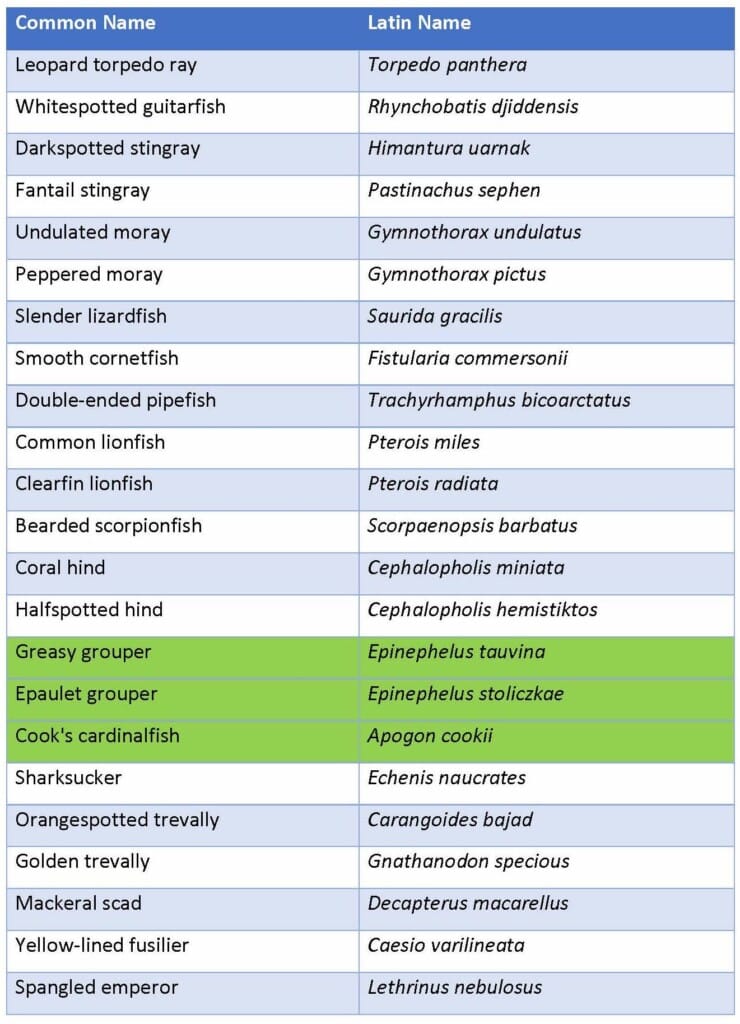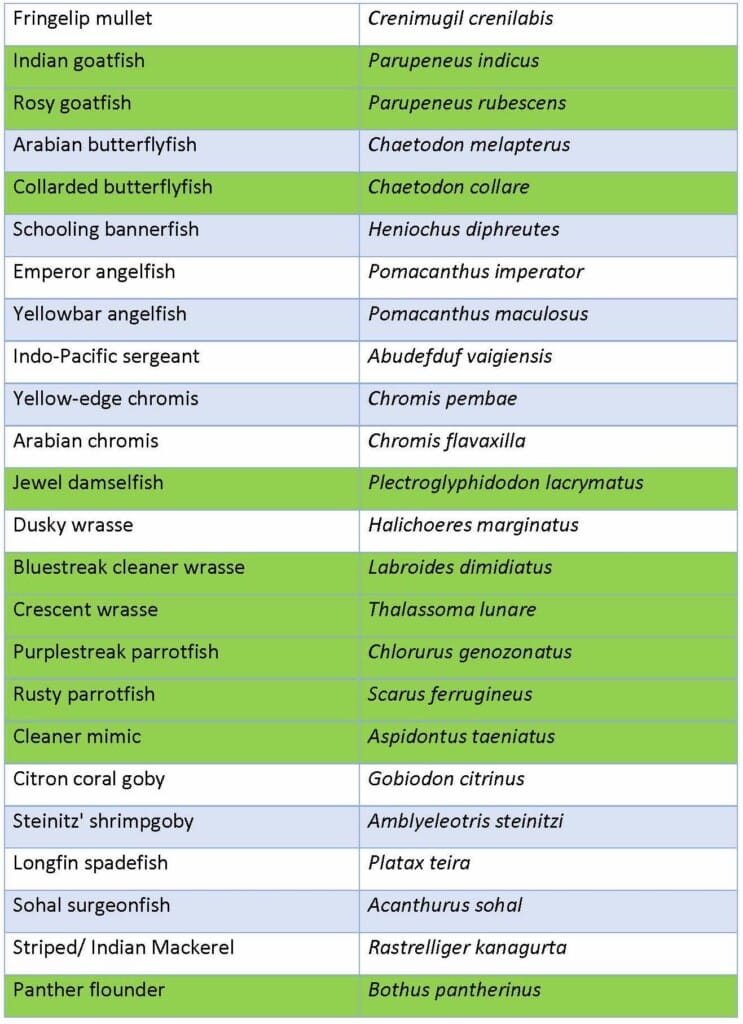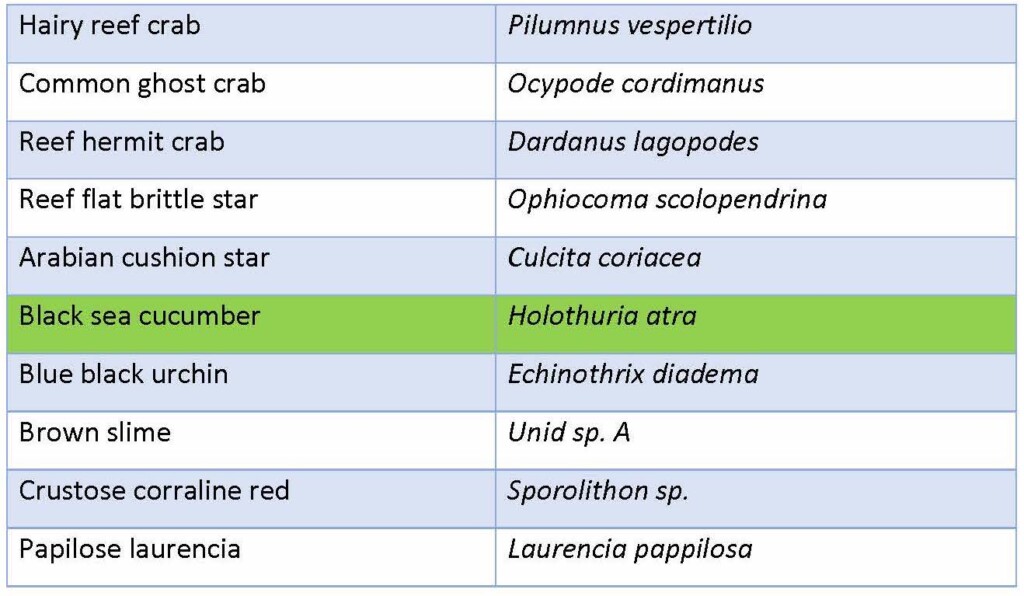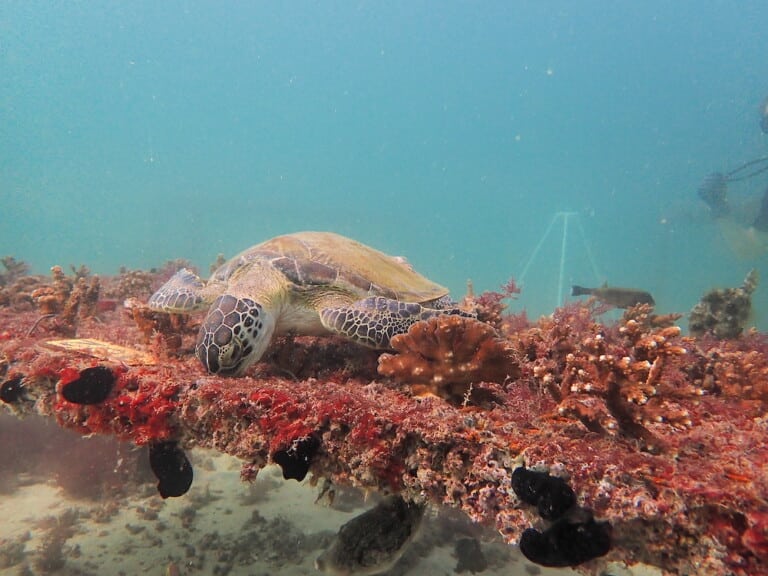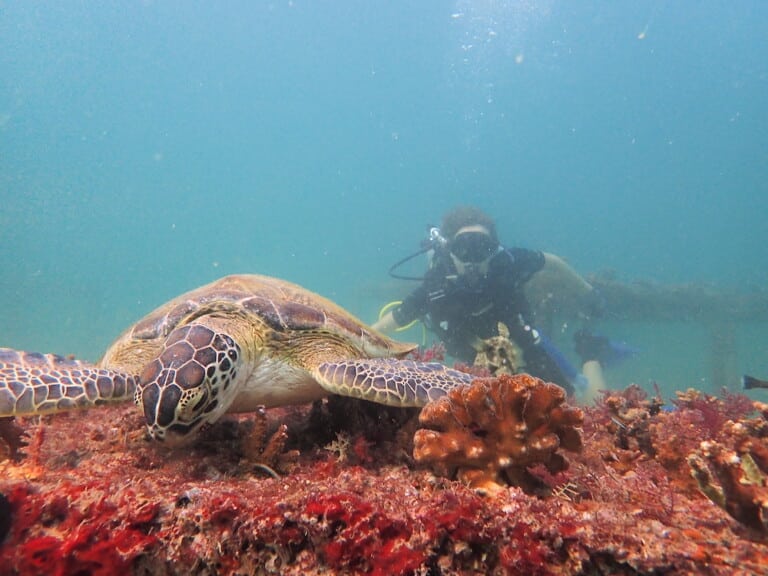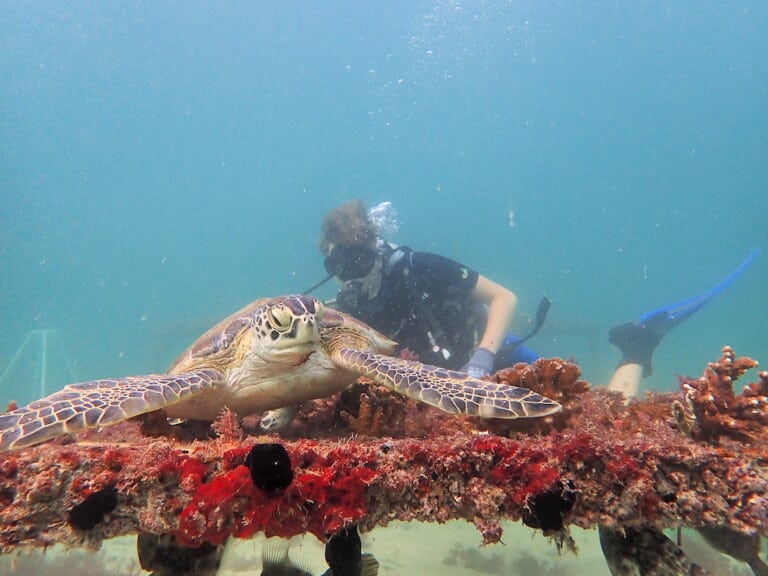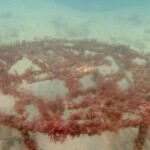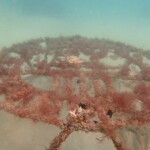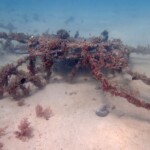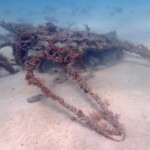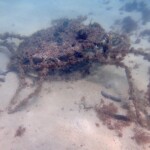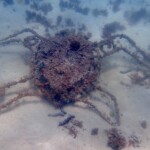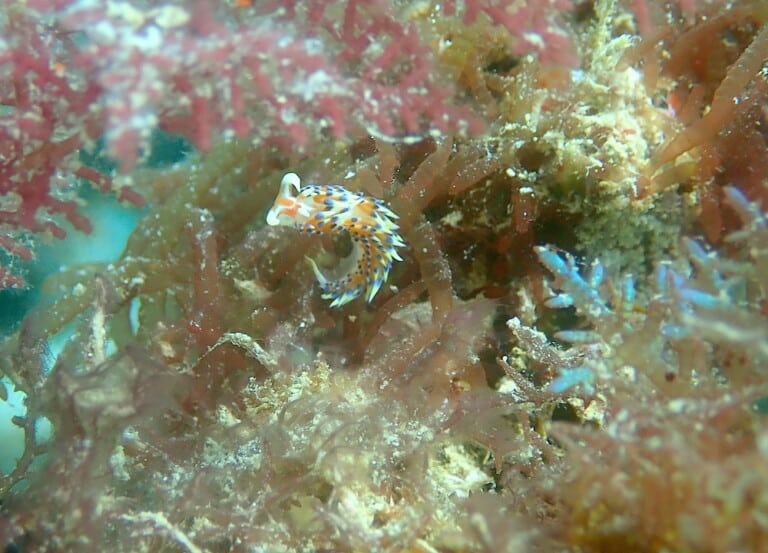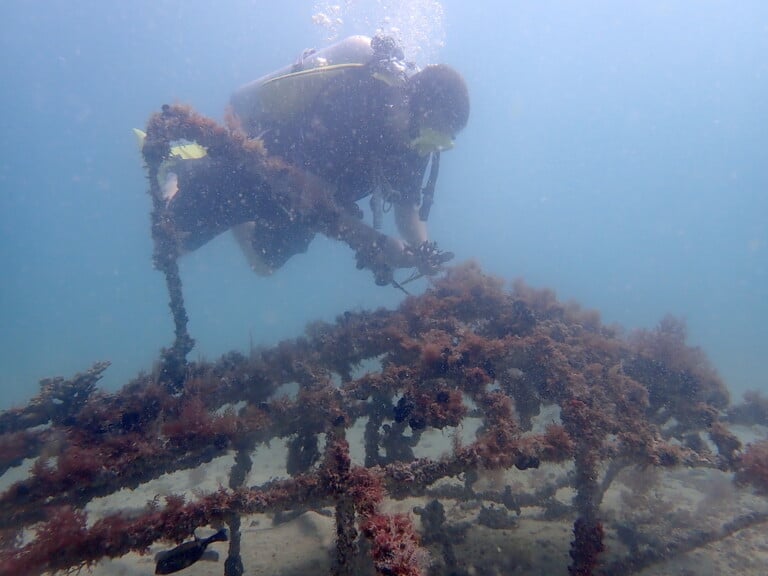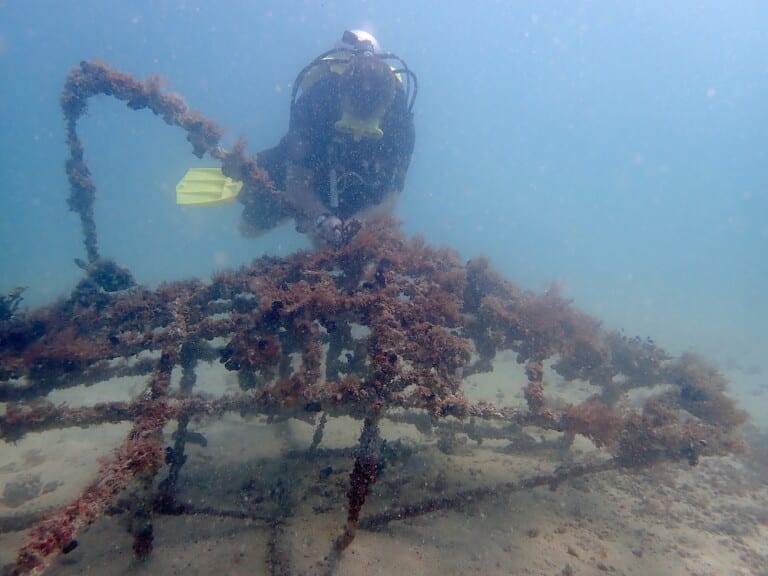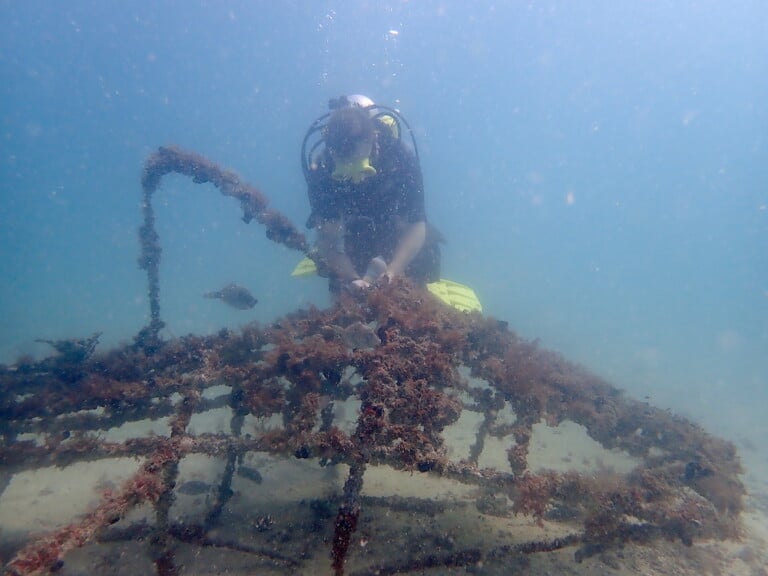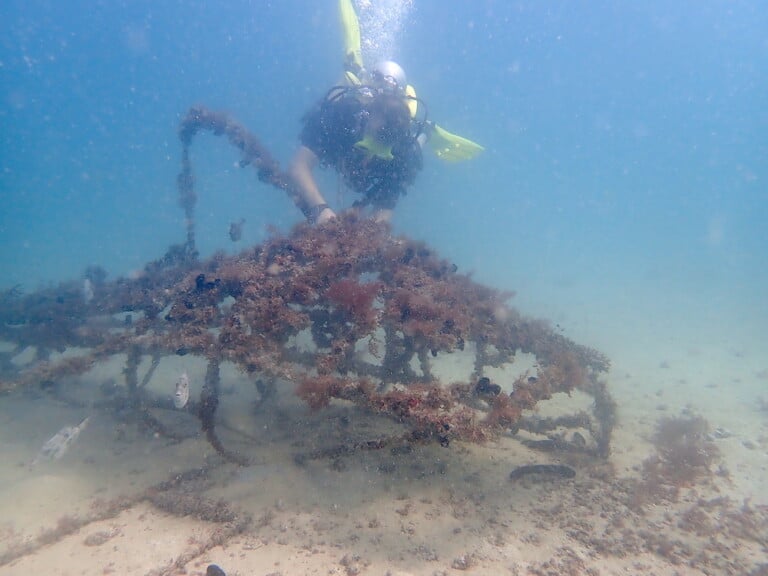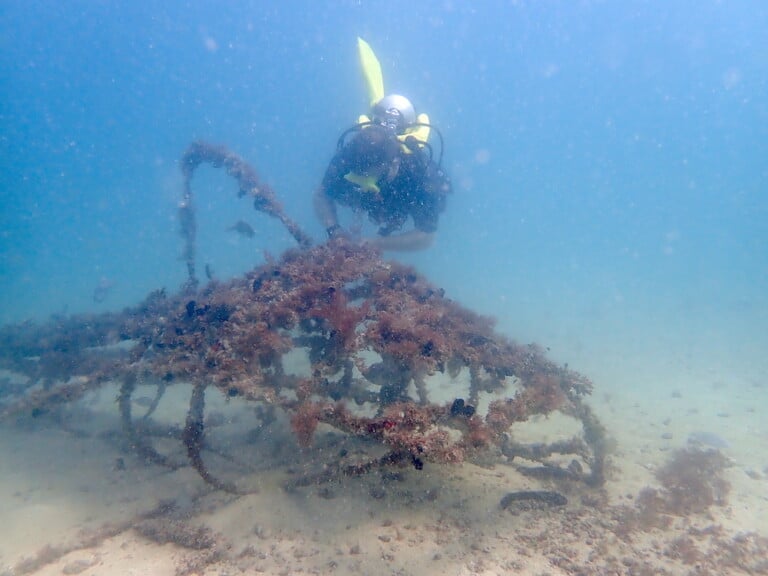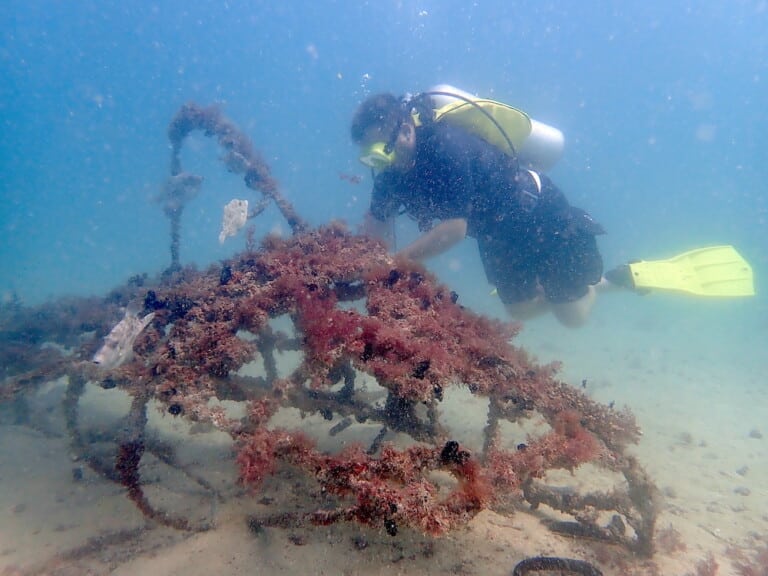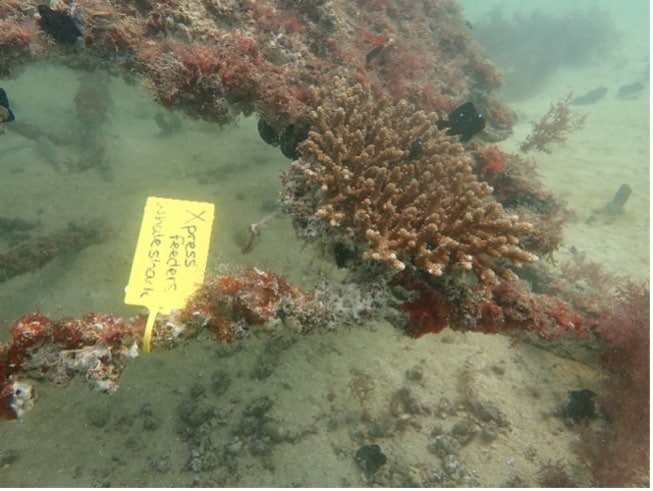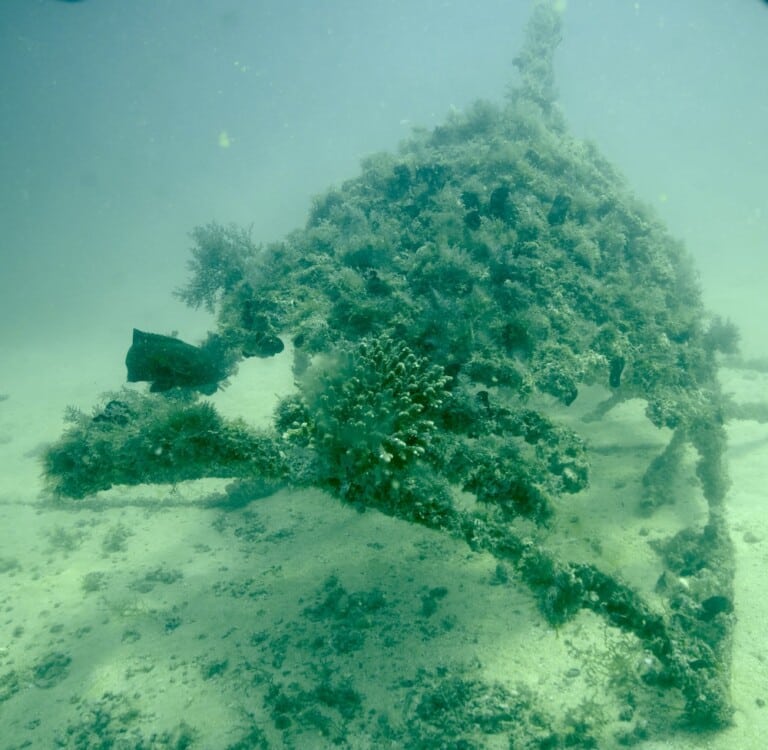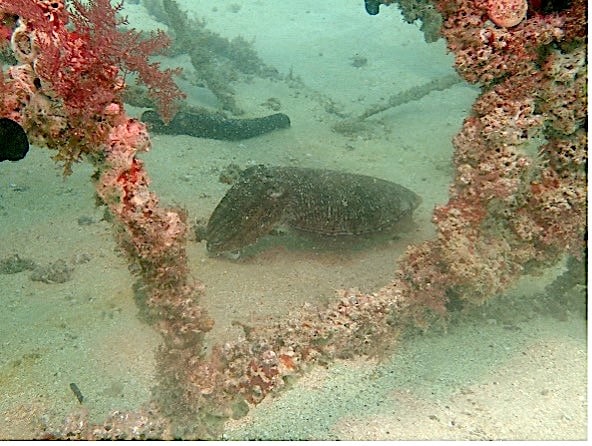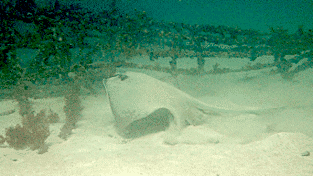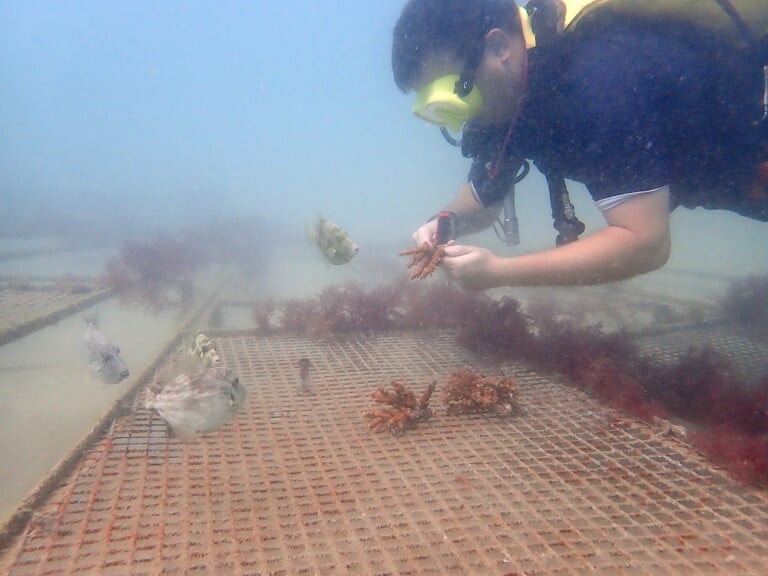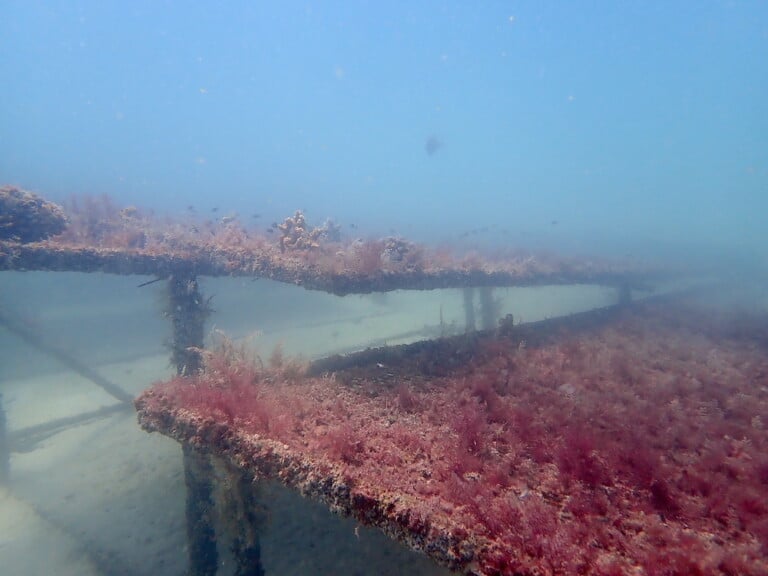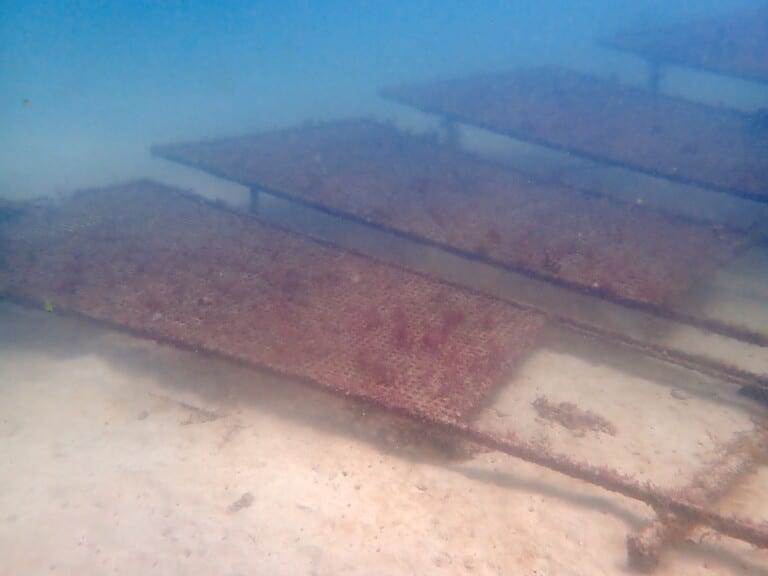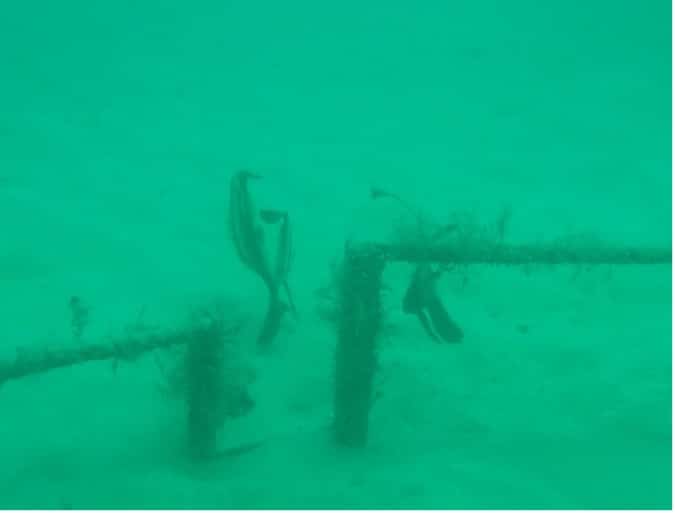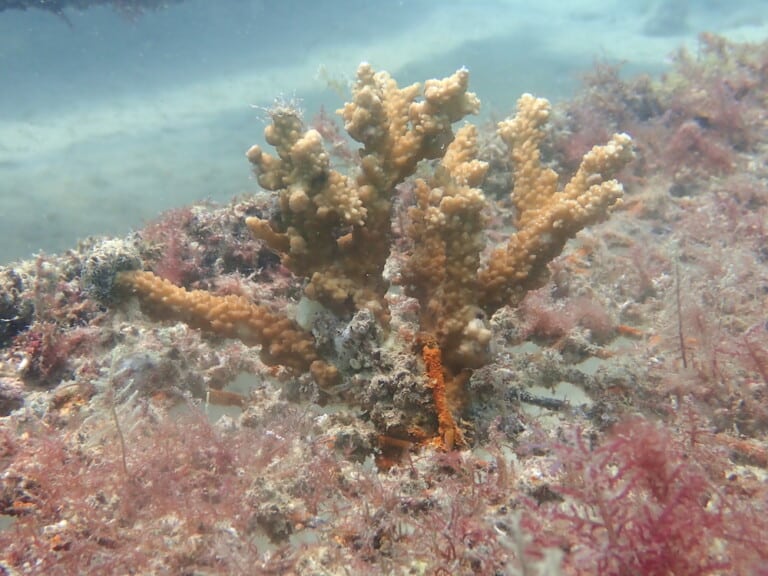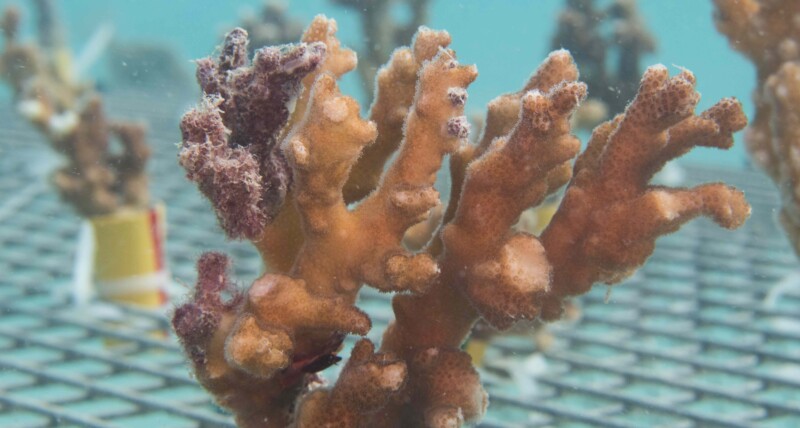July - September 2022
Hot Off The Press!
Before we get into the details of our quarterly update, you will have noticed we have a new logo at the top of the page – it’s official, our marine conservation work has now been given its own name!
The Project REEFrame branding is the result of a significant amount of work over the last three months to define the next phase of our programme, in which we defined the objectives as well as the structural and scientific work we would like to complete over the next three years. This has been submitted to obtain the necessary government permits.
A second piece of news is that Freestyle Divers signed a renewable 3-year partnering agreement with the Marine Environment Research Center Department, which is the national center for marine environmental monitoring and research and sits within the Ministry of Climate Change and Environment. They chose us as a partner to collaborate on environmental monitoring on the East Coast as well as to assist them with coral research and conservation across the UAE.
We are hopeful that this marks an auspicious start to the second phase of our project in 2023! With the “flash news” complete, we can move on to our latest review of the Octopus Garden site.
Summer Conditions on the REEFrame Octopus Garden site
As summer draws to an end and the colder months are starting to set in, we can assess how the Octopus Garden has developed. In the Q2 update, we looked at the analogy of coral propagation as underwater gardening – to continue with that metaphor, our team of staff and volunteers have been tending to our ‘gardening plot’ throughout the summer period, to ensure everything is established and durable for the harsher winter months.
We were fortunate that the ocean conditions over the summer months were far kinder than those we experienced during the summer of 2021. We did experience significant waves of macro algal blooms during the summer, probably due to increased nutrification of the water. This may have been exacerbated by the heavy flooding in the southern end of the Fujairah coastline and the subsequent run-off of nutrients and pollutants into the sea.
Thankfully, the sea surface temperature (SST) remained below the upper limit that our local coral can survive, however to understand this further, we will need to look at coral as an animal.
Coral as an Animal
Coral, an animal related to jellyfish which creates these beautiful structures we call reefs, form the foundations of the ecosystem in shallow tropical marine waters. Every ecosystem is supported by the energy harnessed by plants in photosynthesis, and coral reefs are no exception. Plants aren’t animals, however coral is an animal – so how does the coral form the foundation of the reef ecosystem?
Using the gardening analogy again, when growing plants in a green house on land, there are certain things a plant needs to grow. You can’t just throw a seed on some concrete, cross your fingers and hope that something will grow. You need water (not in short supply in the ocean!), sunlight, substrate and nutrients. So, lets look at these requirements further.
Sunlight: the top 50m of coastal marine waters and the top 200m of open ocean waters are referred to as the photic zone, which is the area where sunlight can penetrate in water.
Different wavelengths of light (AKA colours of light) can penetrate to different depths. The question “Why is the ocean blue?”is often answered incorrectly – it does not reflect the colour of the sky! Blue light penetrates further than red light (red light being absorbed sooner by the water molecules), which means that the blue light travels much further, sothat’s what we can see. Building off the red light being absorbed at shallower depths, the colours of marine plants, algae, tend to be brown. The plants want to absorb the most efficient light for photosynthesis; as an example, mostland plants are green, which means they absorb all other wavelengths of light apart from green. Red light doesn’t penetrate in water very well so the marine plants don’t absorb red light either, mix green and red and you get brown.
Substrate: We wrote about substrate in previous updates, highlighting the fact that coral, planula larvae and algae need a solid porous substrate to grow on, which means that swathes of coastline that have perfect conditions for coral are currently barren due to their sandy substrate. The lack of solid substrate restricts the natural growth of reefs to the limited rocky outcrops along the coast, and the idea of an artificial reef is to provide this substrate, a solid foundation to allow coral to grow and fulfill its role as an ecosystem architect. By providing this foundation in the form of artificial reefs the coral has a place to grow and the ecosystem will form around it, and the coral propagation helps to encourage the reef to grow faster in size.
Nutrients: Any keen gardeners will know that you need nutrient rich soil to grow plants. Normally, coral reef ecosystems are found in crystal clear waters that are devoid of nutrients, which is why coral is so important to that type of marine environment.
Coral is an animal, and what we see underwater is a colony of tiny interconnected coral polyps that gradually form and grow into large and sometimes complex structures. The big question is: where do they get the energy to do this?
The answer is (as always) plants. Within each coral polyp resides an algae called zooxanthellae, it’s a microscopic phytoplankton which also gives the coral its colour. Like other jellyfish, coral is translucent, and it deposits a white calcium carbonate skeleton as it grows, and it’s the coloured algae living within the structure that provides colour to the coral reefs.
The coral and the algae have a mutually beneficial symbiosis, a relationship where they rely on each other for survival. During the day the zooxanthellae provides the coral with the products of photosynthesis, this forms the majority of where coral gets its energy. At night the coral brings out its tentacles and feeds on floating debris and small creatures. The coral then digests this and like all animals, will need to poop, however, the coral recycles its waste by feeding it to the algae. This is how the zooxanthellae gets the nutrients it needs to grow and how the coral can grow and form coral reef ecosystems.
What Happens to Coral When the Water Temperature Gets Too High?
When the water temperature gets too hot (something which is happening with increasing regularity due to climate change) a catastrophic event happens on the reef, which is known as coral bleaching.
Coral bleaching occurs when the water temperatures rise above 33°C for a period of time, usually between 3 days to a week. When this happens, the corals will expel the zooxanthellae leaving just the translucent polyp on top of the white calcium carbonate skeleton, which creates a visual bleaching effect on the corals because the coloured algae has been removed. If water temperatures drop within around 10 days, the zooxanthellae can return to the coral and recover – provided the coral hasn’t developed a disease, which they are more susceptible to during this white phase. However, if the temperatures do not drop then the coral will die, killing the reef. This happened across the east coast of the UAE in the summer of 2021. Fortunately the reef is starting to recover, with our artificial reef and coral propagation initiatives providing a measure of support to this recovery. So, the good news is that this summer the water temperatures did not reach levels where bleaching occurred, meaning there was no double bleaching event.
How Resilient is Coral?
Coral is often seen to be very fragile and weak whereas the opposite is in fact the case. Coral is very resilient,surviving millennia, and if rising temperatures were the only threat to coral then they would be able to adapt and survive. Unfortunately, high temperature is not the only threat; there are a multitude of stressors impacting corals which are weakening them and making them more susceptible to damage. The easiest analogy for this is our own human immune systems. A healthy, stress-free person will shake off a common cold with little thought whereas a run down, tired, or unhealthy person may be bed-ridden for a week by the same illness. In a healthy ocean, corals would be able to adapt to rising temperatures; the problem is that the oceans aren’t healthy.
The Ocean as a Climate Regulator
1.35 billion trillion litres of water, covering 71% of the planet with and average depth of around 3.7 kilometres sustains the life on this planet, maintaining the equilibrium of atmospheric gases and controlling the earth’s climate. The climate of our home planet earth is exceptionally complex, it’s very easy to scoff at incorrect weather forecasts but we must remember the number of interconnected systems which individually impact each other are very complex. Our major negative impacts as residents of this flying rock are currently pollution of the oceans. Pollution can often be interpreted as plastic bags and bottles but pollution is far broader, both in terms of constituents and impact.
A look at Ocean Pollution
Pollution can be gaseous, for example carbon emissions or sulphur emissions.
Pollution can be physical, for example plastic waste or lost fishing equipment, although excess sediment can also be considered as pollution. Over time, an excess of sediment (for example, dust and sand) will bury natural reefs and increase the turbidity (cloudiness) of the water, meaning less sunlight can penetrate, which in turn will decrease coral growth.
Pollution can also be chemical. In this report, we’ll focus on one of many potential marine pollutants: the presence of excess nutrients. As previously mentioned, coral reefs typically grow in nutrient deficient water, utilising the symbiotic relationship with the zooxanthellae to allow for primary production in these food-starved environments. The lack of nutrient in the water prevents algal growth and combined with grazing herbivores feeding upon the small amount of algae that does grow, it allows coral to be the dominant species.
However, pollution in the form of nutrients, for example run off from shore flooding, river run off, fish farming waste or waste from hotels, typically causes algae to grow very fast, which is what we observed on Octopus Garden during the summer when there was apparently a heavy influx of nutrients. The simplest analogy for this would be weeds growing in a flower bed, biologically it’s not a bad thing, however our goal is to produce flowers, not weeds. In the same way, our objective is to promote the growth of coral, which is why we need to regularly “weed” the algal growth on our structures to provide space for the coral to grow.
Coral transplantation
Our main focus over the last quarter has been continued work on the propagation tables as well as fully “planting out” the various artificial reefs. This work needs to be done prior to the winter months to ensure the corals have had time to attach and stabilise after the stress of transplantation before the stormy season sets in with its rough sea conditions. The corals of a suitable size for transplantation can be sourced from two locations:
- The coral nurseryThe fragments suitable for transplantation from the tables will have been fragments that were larger during initial collection from the natural reef, which subsequently needed less time on thenursery tables to reach a size and health appropriate for transplantation.
- Secondly, fragments that were found during collections on the natural reef, which were deemed too large for the propagation tables yet would not have survived if left unattached on the sea floor around the
Why Attach Corals to Artificial Reefs?
Attaching coral colonies to our artificial reefs is the ocean equivalent of taking seedlings from a greenhouse and planting them in a prepared garden flower bed. The transplantation process needs to be well prepared, and the destination site must be ready before transplantation occurs, to minimise stress to the corals.
How We Attach Corals to REEFrame Structures
After immersion, the structures made from steel rebar are quickly covered by barnacles, algae or other marine life; this coverage needs to be removed in the transplantation area to allow the coral to be placed directly onto the bare metal. The easiest way to fix the coral to the structure in the short term is with metal wire, securing it in place. The wire will rust away but by then the coral will have grown and attached itself naturally to the metal structure. For concrete structures a marine epoxy glue can be used.
Other Considerations for Coral Transplantation
Space must be left around each coral colony to allow for its continued growth. A small artificial reef measuring 2m by 2m should have no more than four corals attached, to prevent overcrowding further down the line. If corals grow to a size where they are competing for space, they actually attack each other. The pneumatocysts or jelly fish stingers will fire at the other coral and will start to kill the neighboring colonies. Even if they don’t come into direct contact, a larger coral can overshadow a smaller, poorly placed coral which will reduce the availability of light and probably lead to the smaller corals death.
All these factors have to be considered when transplanting coral. It must be done with the end picture in mind; in a new forest plantation, initially the planted saplings will look rather sparse, however that will change in time as theygrow to form mighty trees. Just like forests, coral reefs take a long time to grow, however as the Chinese proverb says: “the best time to plant a tree was 20 years ago, the second-best time is now”.
Project REEFrame - Reef Roundup
Firetti turtle
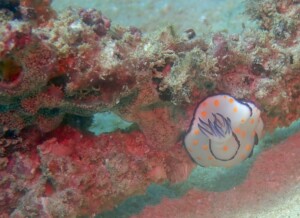
The Firetti turtle is now well established and settled and as you can see in the photos, it is being well taken care of by our expert team of marine gardeners.

On the left, we can see the team cleaning the Firetti Turtle structure for additional transplantation of larger coral colonies. This is an important step, as the metal structures quickly become encrusted with barnacles, sponges, and other marine life, which makes it more difficult for the corals to naturally attach to the solid metal substrate. The area of the frame where we attach the new corals is cleaned back to the metal with scrapers and small wire brushes.
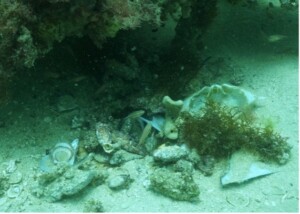
As we mentioned in the previous quarterly report, the area below the Firetti Turtle reef was selected by a pregnant female octopus to build her nest.
The babies were born and we observed them swimming around the structure. Sadly, octopus mothers die after giving birth, however the nest can still be seen in the photo above.
Octopus nests are usually made in holes or natural crevices and the telltale sign to find them are the numerous empty shells from crustacean dinners scattered around the entrance.
The Firetti Turtle now has four large coral colonies growing on it, which over time should be enough to cover the structure without the colonies encroaching on each other.
DITH MENA
The DITH MENA reefs are some of our proudest creations, not just because of the form the reefs took, but also because of how well they are doing. The site “Octopus Garden” was named in part due to the large octopus shaped reef. The DITH MENA reefs are now all fully populated with corals that have been securely attached with wire, and they are close to the stage where the coral has fully attached itself to the structures, which will add strength for the coming “stormy” season.
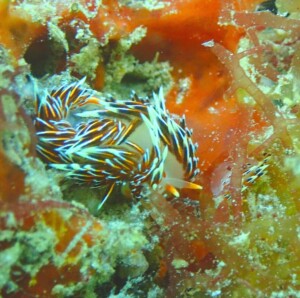
Interestingly, each of the different reefs is generally populated by different species. The tribulus flower is favoured by small reef fish and is now a breeding site for Indian dragon nudibranch Phidiana indica, this species can be seen in the photo to the left.
Groupers and swimming crabs prefer the stingray due to the sheltered shaded space underneath. The octopus reef is the star of the show and seems to also be favoured by a juvenile female green turtle Chelonia mydas. Ever inquisitive, she always seems ready to join us during our maintenance expeditions.
The octopus reef is also home to Arabian angel fish, feather stars and triple fins, with more species coming to visit the attraction on every dive

On the 22nd September, we were lucky to have perfect water conditions for photography and the resident green turtle was in the mood for a photo shoot on the DITH Octopus structure. We include some highlights in the photo gallery below (click to enlarge the images).
The other DITH structures are also fully planted with larger colonies of coral that are doing well. Below, from left to right, we show the corals growing on the DITH MENA Tribulus Flower, a crab scuttling about on the DITH MENA Stingray, and a shot of the DITH MENA Turtle reef with its Lozenge Filefish and Damsel Fish inhabitants.
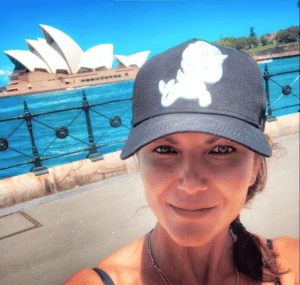 We were excited to welcome visiting Australian photographer Jasmine Carey, who dived the Project REEFrame Octopus Garden site on the 26th September and produced a series of images that have a darker and moodier feel than our usual images, we think she’s amazing and can’t wait to have her visit again. Some samples of her work on the DITH MENA structures are shown in the gallery below. You can click on each image to see a larger version of these wonderfully atmospheric images.
We were excited to welcome visiting Australian photographer Jasmine Carey, who dived the Project REEFrame Octopus Garden site on the 26th September and produced a series of images that have a darker and moodier feel than our usual images, we think she’s amazing and can’t wait to have her visit again. Some samples of her work on the DITH MENA structures are shown in the gallery below. You can click on each image to see a larger version of these wonderfully atmospheric images.
The DITH artificial reef structures are now all fully planted with coral, with four larger pieces on the Tribulus Flower, four larger pieces on the Turtle, six larger pieces on the Stingray and 10 larger pieces on the Octopus. The nursery tables are also maintained to capacity with smaller coral fragments (see below).
DITH MENA Tall Nursery Tables
These tables are a key part of our nursery system to nurture the naturally broken fragments of coral that we have rescued from the seafloor on Dibba Rock before they become covered with sediment and die. Typically we focus on recovering smaller fragments of about 5cm that we can grow to around 10-15cm on the nursery tables, at which time they are large enough to be transplanted to their permanent home on one of the artificial reef structures.
We have different heights for our nursery tables, the “Tall Tables” are 120cm high and each carry up to 162 coral fragments.
Visiting photographer Jasmine Carey’s photos of the DITH MENA Tall Nursery Tables taken on 26/09/22 are shown below, you can click to enlarge the images.
Dell
The Dell reef is now fully planted and the corals have established and attached themselves to the structure ready for the coming heavier winter seas. Crabs and three spot damsel fish aka dominoes inhabit the coral, with goat fish and groupers enjoying the shelter and shade underneath.
The photos above (click to enlarge the images) show the team cleaning the structure in preparation for the transplantation of the larger coral colonies that can be seen in the green crate. These are sourced either from the Project REEFrame coral nursery tables once the fragments have grown large enough, or from larger coral pieces that were naturally broken and recovered from the floor of the nearby Dibba Rock natural reef.
What can also be seen in the photos are the Lozenge Filefish that are our constant companions during maintenance activities. They are fearless and well fed, nipping at our fingers as we clean the reef surfaces and dislodge food that they avidly feast on, to the point where most of our team are now wearing protective gloves! The Dell structure has 4 larger coral colonies planted that are growing nicely and will eventually cover the structure.
Scotch & Soda

Some larger pieces of coral have been planted on the Scotch & Soda structure and are coming along nicely. The Indian dragon nudibranch Phidiana indica quite like this structure, as well as the typical general life we see around the site. Highly poisonous and wonderfully camouflaged juvenile scorpion fish have been spotted on and around the structure, these are best avoided when performing maintenance duties!
The Scotch & Soda structure currently has 4 larger coral colonies planted that are growing well.
Upfill.
The Upfill. table has become a favourite resting place for some of the now resident turtles, where they take their siesta after a hard days munching and chilling out. We have planted coral over the table which is doing well and is now established. However, centrally placed corals are often knocked by the somewhat clumsy turtles.
Surprisingly, we see goat fish on top of this table more than the others. Stingrays and the guitar shark like the lower profile and shaded area underneath this table and can often be found resting there during the day; they are both primarily more active during dawn and dusk.
The Upfill. Table has been planted with five larger coral colonies, which will grow over time to cover the table.
The photos below show a larger coral colony being installed on the Upfill. table as well as one of our resident turtles enjoying a well-earned rest. Click on the photos to enlarge them.
IDS
The IDS table is flourishing, populated with coral fragments that are growing steadily. The table appears to be a favourite for more camouflaged species – spider and decorator crabs as well as the highly poisonous scorpion fish which aren’t quite as much of a happy surprise to unsuspecting volunteers! We have also had a few issues with our beautiful green turtle residents using our coral fragments as a fakir’s bed to scratch their tummies, which has increased the maintenance effort to ensure that all the coral fragments remain solidly in their place on the table. Lastly, we have been testing our new coral measurement system, which uses a white frame to delineate a specifically measured area of the table so that a software program called photoQuad can record the precise sizes of the ~120 coral fragments on the table, to determine their growth over time. Click on the photo below to enlarge them.
Ounass Tables
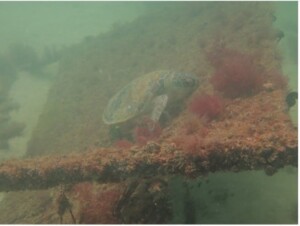 Following the storm damage to the structure, the repair performed on the broken Ounass table initially held up and it was attached to the other two Ounass tables to provide increased stability. Unfortunately, the table subsequently collapsed again and dragged the other two tables down with it. The inclined angle of the table surfaces seems to have caught the currents a lot more than the tables with a flat table surface, which is potentially what contributed to the collapse. Although the legs are currently broken, the table surfaces are intact and the structures are still going strong as a home to wildlife. Turtles can commonly be found grazing there as well as a guitar shark which was spotted underneath one of the structures. Work to repair the table legs is scheduled for the coming months.
Following the storm damage to the structure, the repair performed on the broken Ounass table initially held up and it was attached to the other two Ounass tables to provide increased stability. Unfortunately, the table subsequently collapsed again and dragged the other two tables down with it. The inclined angle of the table surfaces seems to have caught the currents a lot more than the tables with a flat table surface, which is potentially what contributed to the collapse. Although the legs are currently broken, the table surfaces are intact and the structures are still going strong as a home to wildlife. Turtles can commonly be found grazing there as well as a guitar shark which was spotted underneath one of the structures. Work to repair the table legs is scheduled for the coming months.Guinness Book of Records Dome
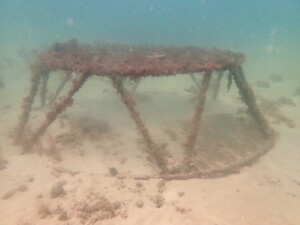
The Guinness Book of Records dome is now fully planted with coral and the coral has attached itself to the structure ready for the winter months. A firm favourite for the goat fish that can be seen perching underneath the structure with groups of 25+ at a time!
Goatfish are an important part of the ecosystem that is establishing itself, you could think of them as the dustbin men – they flit around cleaning the detritus from the sea floor and tabletops. The dome is planted with 5 larger coral colonies that will cover the top of the structure over time.
Maersk Turtle
The Maersk turtle is now fully planted with five larger coral colonies that are well established and naturally attached to the structure ready for the coming winter months. The contrasting shaded area beneath the structure and the absence of any large entry way to access it has made this structure very attractive to smaller species that like shaded and protected areas during the day. An array of different groupers and goatfish can often be found huddled underneath. The Maersk structure has been planted with 5 larger coral colonies.
X-Press Feeders Whaleshark
The Indian Dragon Nudibranchs phidiana indica tend to really like this structure. Cuttle fish have been spotted in the belly of the whale shark, and stingrays have also been spotted next to this structure using it as a cleaning station. Home to large schools of tiny juvenile fish to the point they envelop the whole top of the structure like a haze, which is a welcome sight as it shows the structure is providing crucial habitat to help build fish populations.
Gallery of photos of the whale shark is shown below, please click the photos to enlarge them.
The visiting photographer Jasmine Carey’s photo of the X-Press Feeders Whaleshark reef was taken on 26/09/22 and is shown below

Mandarin Oriental Fan
The structure is still developing and is so large that it’s hard to capture it all in one photo! It has already been planted with some coral and with the additional volunteers currently being trained, we plan to use this structure as a dedicated space for them to tend to regularly. Juvenile longfin batfish are often spotted here as well as groups of juvenile goatfish. We’ve also seen green turtles here.
Species Observed on the REEFrame Octopus Garden Site
It’s very exciting to see the number of species that have colonized the site, especially considering that in July 2021, the site was barren sand. We have identified 80 species on the site so far, with a further list of animals that we are researching to confirm their identity. Seventeen of the species are commonly seen around all structures, these are highlighted in green.
